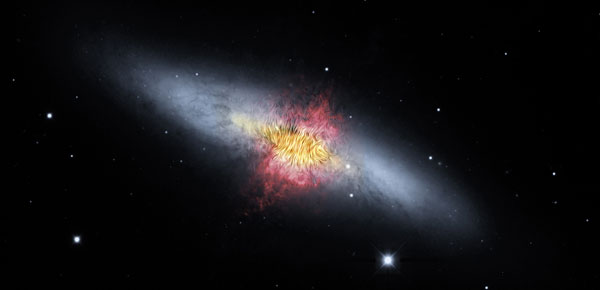NASA’s SOFIA airborne observatory returns a striking far-infrared view of the Cigar Galaxy and its “galactic superwind.”
The Cigar Galaxy (M82), a spiral galaxy viewed edge-on, is burning with new stars. They form at a rate ten times faster than the Milky Way and push dust and gas out of the galaxy in a “superwind.” This neat new image from the Stratospheric Observatory for Infrared Astronomy (SOFIA) shows how the wind is dragging the galaxy’s magnetic field right along with it.

NASA / SOFIA / E. Lopez-Rodiguez; NASA / Spitzer / J. Moustakas et al.
The Cigar Galaxy is the archetypal starburst galaxy, having experienced two recent spates of star formation. One occurred10 million years ago in its nucleus, and another sprang up 5 million years ago in a ring around the galaxy’s core. This froth of starbirth drives a so-called galactic superwind: dust, gas, and radiation that flow out of the galaxy and into intergalactic space.
To observe this wind, Terry Jay Jones (University of Minnesota) and colleagues applied for time on NASA’s SOFIA airborne observatory, which soars above much of the atmosphere that would absorb the infrared light it’s designed to collect. A modified Boeing 747 flies the 2.7-meter telescope in whatever careening trajectories are necessary to best view its targets that night.
Jones and colleagues used the High-resolution Airborne Wideband Camera-plus (HAWC+) instrument aboard SOFIA to observe far-infrared light (at wavelengths of 53 and 154 microns) coming from the Cigar Galaxy. Hot dust within giant, gaseous star-factory clouds emits this light. But dust isn’t perfectly spherical; dust grains tend to be oblong, and they tend to align with the ambient magnetic field that threads the galaxy. So the emission from these dust grains is polarized in a way that tells astronomers which way the magnetic field is pointing.
What Jones’s team found was that within 2,000 light-years of the galaxy’s center, the wind that charges into intergalactic space carries the galaxy’s magnetic field along with it. The polarization in the image above shows that the magnetic field is pretty much vertical in this central region. Outside this region, the magnetic field is horizontal, threading the plane of the galaxy.
None of this is a surprise — the observations fall in line with what Jones’s team expected to see. At the same time, the observations provide a valuable clue, as astronomers don’t understand exactly how galaxies blow out such winds. All starburst galaxies seem to have superwinds like the one coming from the Cigar, so the intense star formation must be involved but the mechanism remains unclear. These observations — in addition to providing a striking view of the Cigar Galaxy not available through your standard backyard telescope — will help astronomers puzzle apart wind-driving mechanisms.
 4
4









Comments
Rod
March 8, 2019 at 12:25 pm
M82 is a good telescope target. M81 and M82 < 40' apart so generally you can fit both into the eyepiece field of view. I last viewed M81 and M82 on 04-April-18 "32-mm plossl at 31x and 1.6 degree true field of view gave a very good view of M81 and M82 together in the same field. Nice and bright galaxy pair here to enjoy." This was using a 90-mm refractor, I plan to observe again using my 10-inch Newtonian. While I observe in optical light, M82 is always interesting like perhaps something is going on there 🙂
You must be logged in to post a comment.
bwana
March 8, 2019 at 7:50 pm
A beautiful composite image! bwa
You must be logged in to post a comment.
philip-gardner
March 9, 2019 at 12:55 am
Monica,Thanks for the image, it is an impressive bit of kit! One of the best I have seen.
You must be logged in to post a comment.
Sciencesprrings
August 28, 2020 at 4:44 pm
There is no identification of what telescope(s) at Kitt Peak were involved in this image.
I need the name of the telescope(s). You have my email address.
You must be logged in to post a comment.
You must be logged in to post a comment.